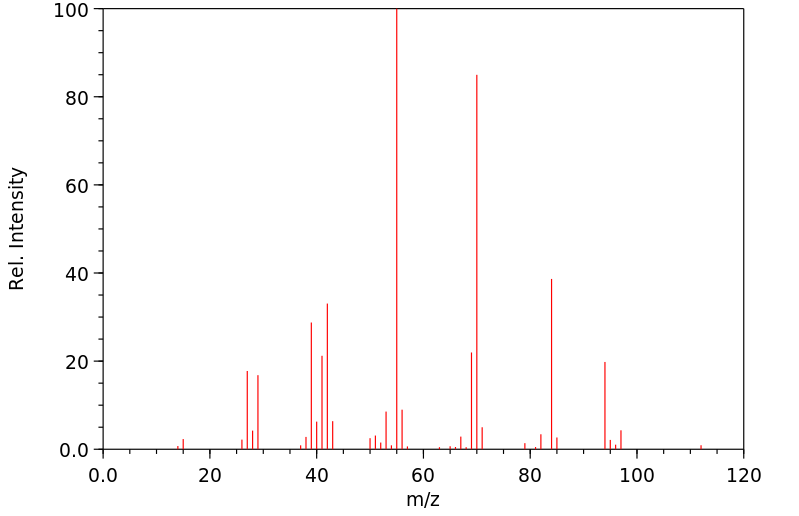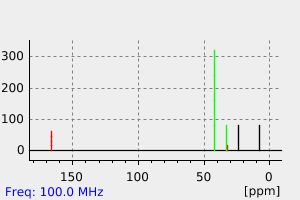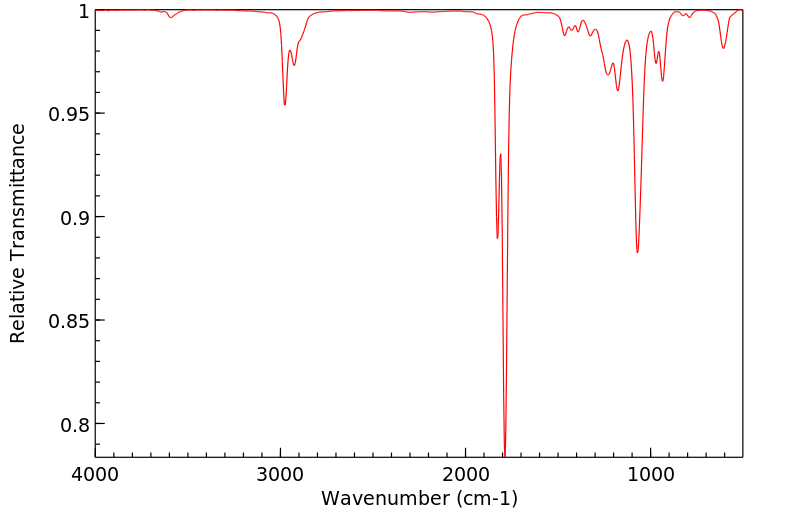3-乙基-3-甲基戊二酸酐 | 6970-57-6
中文名称
3-乙基-3-甲基戊二酸酐
中文别名
——
英文名称
3-ethyl-3-methylglutaric anhydride
英文别名
3-ethyl-3-methyl-pentanedioic acid anhydride;3-ethyl-3-methyl-glutaric acid-anhydride;3-Aethyl-3-methyl-glutarsaeure-anhydrid;4-ethyldihydro-4-methyl-2H-pyran-2,6(3H)-dione;4-ethyl-4-methyl-dihydro-pyran-2,6-dione;4-ethyl-4-methyloxane-2,6-dione
CAS
6970-57-6
化学式
C8H12O3
mdl
MFCD00006685
分子量
156.181
InChiKey
VSVZSLYJGKSCBI-UHFFFAOYSA-N
BEILSTEIN
——
EINECS
——
-
物化性质
-
计算性质
-
ADMET
-
安全信息
-
SDS
-
制备方法与用途
-
上下游信息
-
文献信息
-
表征谱图
-
同类化合物
-
相关功能分类
-
相关结构分类
物化性质
-
沸点:185 °C20 mm Hg(lit.)
-
密度:1.058 g/mL at 25 °C(lit.)
-
闪点:203 °F
计算性质
-
辛醇/水分配系数(LogP):1.3
-
重原子数:11
-
可旋转键数:1
-
环数:1.0
-
sp3杂化的碳原子比例:0.75
-
拓扑面积:43.4
-
氢给体数:0
-
氢受体数:3
安全信息
-
危险品标志:Xi
-
安全说明:S24/25,S26,S37/39
-
危险类别码:R36/37/38
-
WGK Germany:3
-
海关编码:2917190090
SDS
| Name: | 3-Ethyl-3-methylglutaric anhydride 97% Material Safety Data Sheet |
| Synonym: | None |
| CAS: | 6970-57-6 |
Synonym:None
Section 2 - COMPOSITION, INFORMATION ON INGREDIENTS
| CAS# | Chemical Name | content | EINECS# |
| 6970-57-6 | 3-ethyl-3-methylglutaric anhydride | 97 | 230-194-4 |
Risk Phrases: 36/37/38
Section 3 - HAZARDS IDENTIFICATION
EMERGENCY OVERVIEW
Irritating to eyes, respiratory system and skin.Moisture sensitive.
Potential Health Effects
Eye:
Causes eye irritation. May cause chemical conjunctivitis.
Skin:
Causes skin irritation.
Ingestion:
May cause gastrointestinal irritation with nausea, vomiting and diarrhea.
Inhalation:
Causes respiratory tract irritation. Can produce delayed pulmonary edema.
Chronic:
Effects may be delayed.
Section 4 - FIRST AID MEASURES
Eyes: Immediately flush eyes with plenty of water for at least 15 minutes, occasionally lifting the upper and lower eyelids. Get medical aid.
Skin:
Get medical aid. Flush skin with plenty of water for at least 15 minutes while removing contaminated clothing and shoes. Wash clothing before reuse.
Ingestion:
Never give anything by mouth to an unconscious person. Get medical aid. Do NOT induce vomiting. If conscious and alert, rinse mouth and drink 2-4 cupfuls of milk or water.
Inhalation:
Remove from exposure and move to fresh air immediately. If not breathing, give artificial respiration. If breathing is difficult, give oxygen. Get medical aid. Do NOT use mouth-to-mouth resuscitation.
Notes to Physician:
Treat symptomatically and supportively.
Section 5 - FIRE FIGHTING MEASURES
General Information:
As in any fire, wear a self-contained breathing apparatus in pressure-demand, MSHA/NIOSH (approved or equivalent), and full protective gear. During a fire, irritating and highly toxic gases may be generated by thermal decomposition or combustion.
Extinguishing Media:
Do NOT get water inside containers. Use water spray, dry chemical, carbon dioxide, or appropriate foam.
Section 6 - ACCIDENTAL RELEASE MEASURES
General Information: Use proper personal protective equipment as indicated in Section 8.
Spills/Leaks:
Absorb spill with inert material (e.g. vermiculite, sand or earth), then place in suitable container. Provide ventilation. Do not get water inside containers.
Section 7 - HANDLING and STORAGE
Handling:
Wash thoroughly after handling. Remove contaminated clothing and wash before reuse. Avoid contact with eyes, skin, and clothing. Avoid ingestion and inhalation. Use with adequate ventilation. Do not allow contact with water. Keep from contact with moist air and steam.
Storage:
Store in a tightly closed container. Store in a cool, dry, well-ventilated area away from incompatible substances. Store protected from moisture.
Section 8 - EXPOSURE CONTROLS, PERSONAL PROTECTION
Engineering Controls:
Facilities storing or utilizing this material should be equipped with an eyewash facility and a safety shower. Use adequate ventilation to keep airborne concentrations low.
Exposure Limits CAS# 6970-57-6: Personal Protective Equipment Eyes: Wear appropriate protective eyeglasses or chemical safety goggles as described by OSHA's eye and face protection regulations in 29 CFR 1910.133 or European Standard EN166.
Skin:
Wear appropriate protective gloves to prevent skin exposure.
Clothing:
Wear appropriate protective clothing to prevent skin exposure.
Respirators:
A respiratory protection program that meets OSHA's 29 CFR 1910.134 and ANSI Z88.2 requirements or European Standard EN 149 must be followed whenever workplace conditions warrant respirator use.
Section 9 - PHYSICAL AND CHEMICAL PROPERTIES
Physical State: Liquid
Color: after melting, clear colorless
Odor: none reported
pH: Not available.
Vapor Pressure: Not available.
Viscosity: Not available.
Boiling Point: 185 deg C @ 20.00mm Hg
Freezing/Melting Point: Not available.
Autoignition Temperature: Not applicable.
Flash Point: 95 deg C ( 203.00 deg F)
Explosion Limits, lower: Not available.
Explosion Limits, upper: Not available.
Decomposition Temperature: Not available.
Solubility in water: May decompose.
Specific Gravity/Density: 1.0580g/cm3
Molecular Formula: C8H12O3
Molecular Weight: 156.18
Section 10 - STABILITY AND REACTIVITY
Chemical Stability:
Stable at room temperature in closed containers under normal storage and handling conditions. May decompose on exposure to moist air or water.
Conditions to Avoid:
Incompatible materials, moisture, excess heat, strong oxidants.
Incompatibilities with Other Materials:
Strong oxidizing agents, acids, bases, moisture, water.
Hazardous Decomposition Products:
Carbon monoxide, irritating and toxic fumes and gases, carbon dioxide.
Hazardous Polymerization: Has not been reported
Section 11 - TOXICOLOGICAL INFORMATION
RTECS#:
CAS# 6970-57-6 unlisted.
LD50/LC50:
Not available.
Carcinogenicity:
3-ethyl-3-methylglutaric anhydride - Not listed by ACGIH, IARC, or NTP.
Section 12 - ECOLOGICAL INFORMATION
Section 13 - DISPOSAL CONSIDERATIONS
Dispose of in a manner consistent with federal, state, and local regulations.
Section 14 - TRANSPORT INFORMATION
IATA
Not regulated as a hazardous material.
IMO
Not regulated as a hazardous material.
RID/ADR
Not regulated as a hazardous material.
Section 15 - REGULATORY INFORMATION
European/International Regulations
European Labeling in Accordance with EC Directives
Hazard Symbols: XI
Risk Phrases:
R 36/37/38 Irritating to eyes, respiratory system
and skin.
Safety Phrases:
S 24/25 Avoid contact with skin and eyes.
WGK (Water Danger/Protection)
CAS# 6970-57-6: No information available.
Canada
None of the chemicals in this product are listed on the DSL/NDSL list.
CAS# 6970-57-6 is not listed on Canada's Ingredient Disclosure List.
US FEDERAL
TSCA
CAS# 6970-57-6 is not listed on the TSCA inventory.
It is for research and development use only.
SECTION 16 - ADDITIONAL INFORMATION
N/A
上下游信息
-
上游原料
中文名称 英文名称 CAS号 化学式 分子量 3-乙基-3-甲基戊二酸 3-ethyl-3-methylglutaric acid 5345-01-7 C8H14O4 174.197 -
下游产品
中文名称 英文名称 CAS号 化学式 分子量 3-乙基-5-甲氧基-3-甲基-5-氧代戊酸 3-ethyl-3-methyl-glutaric acid monomethyl ester 5338-98-7 C9H16O4 188.224
反应信息
-
作为反应物:描述:参考文献:名称:Benica; Wilson, Journal of the American Pharmaceutical Association (1912), 1950, vol. 39, p. 451,453摘要:DOI:
-
作为产物:描述:参考文献:名称:Dioxocyclohexane carboxylic acid phenyl amide derivatives for modulating voltage-gated potassium channels and pharmaceutical compositions containing the same摘要:二氧环己烷羧酸苯胺衍生物,其通式为(I)的化合物或其互变异构体或其药学上可接受的盐,以及含有这些化合物的药物组合物被提供:这些二氧环己烷羧酸苯胺衍生物可用于治疗与一个或多个Kv1.1电压门控钾通道异常调节相关的多种病症。公开号:US20060014826A1
文献信息
-
N-acylsulfonamide apoptosis promoters申请人:——公开号:US20020055631A1公开(公告)日:2002-05-09N-Benzoyl arylsulfonamides having the formula 1 are BCL-Xl inhibitors and are useful for promoting apoptosis. Also disclosed are BCL-Xl inhibiting compositions and methods of promoting apoptosis in a mammal.
-
N-Acylsulfonamide apoptosis promoters申请人:——公开号:US20020086887A1公开(公告)日:2002-07-04N-Benzoyl arylsulfonamides having the formula 1 Are BCL-X1 inhibitors and are useful for promoting apoptosis. Also disclosed are BCL-X1 inhibiting compositions and methods of promoting apoptosis in a mammal.
-
Anti-AIDS Agents. 34. Synthesis and Structure−Activity Relationships of Betulin Derivatives as Anti-HIV Agents作者:I-Chen Sun、Hui-Kang Wang、Yoshiki Kashiwada、Jing-Kang Shen、L. Mark Cosentino、Chin-Ho Chen、Li-Ming Yang、Kuo-Hsiung LeeDOI:10.1021/jm980391g日期:1998.11.1followed by 3',3'-tetramethylene glutaryl derivatives (10 > 9 > 11 > 12, 18 > 17 > 19 > 20). The most potent compound, 10, has two 3',3'-dimethylglutaryl groups and displays significant anti-HIV potency with an EC50 value of 0.000 66 microM and a TI of 21 515. Results for compounds (22 and 23) without a C-3 acyl group confirmed the importance of the C-3 acyl group to the anti-HIV effect. With 3',3'-tetramethylene琥珀酰和3'-取代的戊二酰桦木酚衍生物比二氢白桦木衍生物具有更强的抗HIV活性和更高的治疗指数(TI)值,比率为1.2:1至15:1(参见7和15、9、17、10和10)和18、11和19,以及12和20)。对于各种3'-取代的戊二酰化合物,从强抑制到弱抑制的抗HIV效应顺序为3',3'-二甲基,3'-甲基,3'-乙基-3'-甲基,然后是3 ',3'-四亚甲基戊二酰芳基衍生物(10> 9> 11> 12、18> 17> 19> 20)。最有效的化合物10具有两个3',3'-二甲基戊二烯基,并显示出显着的抗HIV效能,EC50值为0.000 66 microM,TI为21515。没有C-3酰基的化合物(22和23)的结果证实了C-3酰基对抗HIV作用的重要性。使用3',3'-四亚甲基戊二酰戊二烯衍生物,三酰基29显示出比二酰基12更强的抑制作用;相反,3',3'-二甲基戊二烯基化合物显示相反的结果。3-酮化合物(35和36)和2
-
Anti-AIDS Agents. 30. Anti-HIV Activity of Oleanolic Acid, Pomolic Acid, and Structurally Related Triterpenoids作者:Yoshiki Kashiwada、Hui-Kang Wang、Tsuneatsu Nagao、Susumu Kitanaka、Ichiro Yasuda、Toshihiro Fujioka、Takashi Yamagishi、L. Mark Cosentino、Mutsuo Kozuka、Hikaru Okabe、Yasumasa Ikeshiro、Chang-Qi Hu、Eric Yeh、Kuo-Hsiung LeeDOI:10.1021/np9800710日期:1998.9.1with an IC50 value of 21.8 microg/mL [therapeutic index (T. I.) 12.8]. Pomolic acid, isolated from R. woodsii and H. capitata, was also identified as an anti-HIV agent (EC50 1.4 microg/mL, T. I. 16.6). Although ursolic acid did show anti-HIV activity (EC50 2.0 microg/mL), it was slightly toxic (IC50 6.5 microg/mL, T. I. 3.3). A new triterpene (11) was also isolated from the CHCl3-soluble fraction of齐墩果酸(1)已从多种植物中鉴定为抗HIV成分,包括蔷薇木(叶子),甘蓝Prosopis glandulosa(叶子和嫩枝),杜鹃花(整个植物),蒲桃(叶子),Hyptis capitata(整个植物) )和Ternstromia Gymnanthera(空中部分)。它抑制EC-1值为1.7 microg / mL的急性感染H9细胞中的HIV-1复制,并抑制IC50值为21.8 microg / mL的H9细胞生长[治疗指数(TI)12.8]。分离自伍兹木和人参中的波摩尔酸也被鉴定为抗HIV药物(EC50为1.4 microg / mL,TI 16.6)。尽管熊果酸确实显示出抗HIV活性(EC50为2.0微克/毫升),但毒性微弱(IC50为6.5微克/毫升,TI 3.3)。还从伍德氏木。的CHCl3可溶级分中分离出了新的三萜(11),尽管它没有显示抗HIV活性。通过光谱检查确定11的结构为
-
Highly diastereoselective desymmetrisation of cyclic meso-anhydrides and derivatisation for use in natural product synthesis作者:Amanda C. Evans、Deborah A. Longbottom、Masato Matsuoka、John E. Davies、Richard Turner、Vilius Franckevičius、Steven V. LeyDOI:10.1039/b813494d日期:——A new and efficient desymmetrisation of succinic and glutaric cyclic meso-anhydrides is described, providing excellent yields and diastereoselectivities in most cases. Derivatisation of the desymmetrised products is demonstrated by their conversion into mono-protected 1,4-diols. General synthetic utility of the method is established by its application towards a key fragment in the total synthesis of the immunosuppressant antitumour natural product, rapamycin.
表征谱图
-
氢谱1HNMR
-
质谱MS
-
碳谱13CNMR
-
红外IR
-
拉曼Raman
-
峰位数据
-
峰位匹配
-
表征信息
同类化合物
(+)-(3R)-3-{[叔丁基(二甲基)硅基]氧基}二氢呋喃-2(3H)-酮
龙胆黄碱
龙胆酮胺
高良姜萜内酯
高柠檬酸-gamma-内酯
高普伐他汀内酯二-(叔-丁基二甲基硅烷基)醚
马桑内酯
顺式蒈醛酸内酯
顺式-3,5-二甲基二氢-2H-吡喃-2,6(3H)-二酮
顺式-1,3-环戊烷二甲酸酐
顺式-1,3-环己烷二甲酸酐
阿拉伯酸,2-氨基-2,3,5-三脱氧-3-甲基-,γ-内酯(9CI)
酸,(1S,3R,4R,5R)-3,4-二羟基-7-羰基-6-氧杂二环[3.2.1]辛-1-基2,2,2-三氯乙基酯碳
辛伐他汀4'-甲基醚
辛伐他汀
软木三萜酮3,4-内酯
试剂Menthide
试剂6-Allyl-epsilon-caprolactone
表洛伐他汀
蜂毒
藻酸钠
薇甘菊内酯
葡醛内酯
葡庚糖酸内酯
葡庚糖酸內酯
莫那可林X
莫那可林L
莫那可林J
脱氢抗坏血酸
聚乌拉坦
聚(epsilon-己内酯-delta-戊内酯)
羟基马桑毒内酯
羟基蓍含蓍素
羟基己酸内酯与2,2-二甲基-1,3-丙二醇的聚合物
美伐他汀
绵毛马兜铃内酯
糖质酸-1,4-内酯
穿心莲内酯
科立内脂二醇
硫丹内酯
石蚕苷A
甲酰辛伐他汀
甲瓦龙酸内酯-D4
甲瓦龙酸内酯-D3
甲瓦龙酸内酯-1-13C
甲瓦龙酸内酯-1,2-13C2
甲瓦龙酸内酯
甲基丙烯酸甲瓦龙酸内酯
甲基[(1S,5R,6R)-3-氧代-2-氧杂双环[3.2.1]辛-6-基]乙酸酯
瑞舒伐他汀杂质113









